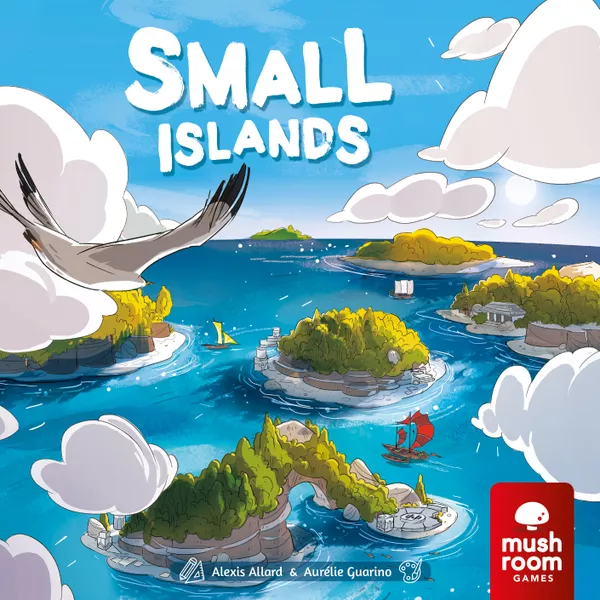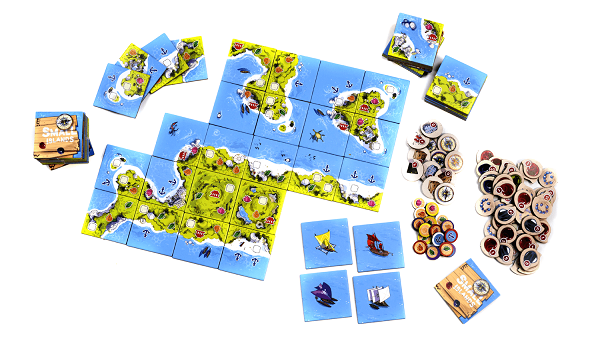Build and Explore an Ocean of Small Islands

Lay down tiles and explore islands of resources and temples, as your clan spreads out in this tile-laying game with ever-changing scoring goals.
Published by Lucky Duck Games and MushrooM Games, Small Islands is a 30-minute game for 1-4 players.
Gameplay
Small Islands is played over, at most, four rounds. At the start of each round, players will have one objective card in their hand. They will then each be dealt two more. You choose one objective card to discard, one to have in your hand at the start of the next round, and one to be your objective for the current round.
Each player also starts each round with a hand of two island tiles. Tiles will show some combination of water and island and can show different natural resource icons of which there are three different types. Island tiles can also have a port symbol, a temple, and a building site.
On your turn, you may take one of the three island tiles in the display into your hand and then play one tile onto the board. When you play an island tile, it must be placed adjacent to at least one other tile, and the landscape must make logical sense (i.e., water must connect to water, and land must connect to land).
Each player also has four bonus tokens. You can play one of these on your turn, and on any tile already on the table. These are either resources, in which case you cover another resource on that tile to replace it with the resource type depicted on the token, or a port token.
When you take a tile from the display, you replace it. At the start of each round, you place six island tiles in the navigational stack, and when refilling the display, you start by drawing from there. Once this stack runs out, you refill it from the general draw pile. However, once the navigational stack is empty, instead of drawing an island tile and placing it on your turn, you can instead choose to play the ship tile of your color and play it — or one of the gray ships if you are not playing with a full player count, as there are always four ships in the game. This triggers the end of the round.
Once a round ends, everyone reveals their objective cards and then scores them, starting with the player who placed the ship that round. Objective cards will typically require a certain number or combination of resources and/or icons on an island in order to score that island. It will then list how many points you get for completing that objective. Again, this is typically based on the number of certain elements on an island. For example, one objective card requires an island to have at least one temple and two flowers on it and then scores you one point per temple and one point per flower on that island.
If an island meets your objective card’s requirement, you may choose to place one of your clan houses on it. The island must also have an empty building site for your clan house in order to score it. You can score multiple islands at the end of a round if there are multiple islands that meet your objective card, but you only have four clan houses each round and are limited to eight during the entire game. You do not have to score an island if you do not wish. An island does not have to be completed in order for you to score it, but you cannot have more than one of your own clan houses on an island. Once you have scored an island, you cannot use it to score points again later in the game. Once you have completed scoring your objective card, you discard it.
Once everyone has scored their objective card, you set up for a new round. The game ends if all the ship tiles have been placed, if there are not enough island tiles to place six in the navigational stack at the start of the round, or if there are no more island tiles and you cannot legally play a ship tile (in which case you end the round and score everyone’s objective card for that round). At the end of the game, you total up all the points you earned during the game and also score one point for each port symbol that appears in the eight tiles surrounding the ship tile of your player color. The person with the most points wins.

Review
Small Islands is a pretty short tile-laying game with round ends triggering fairly quickly and turns going by fast. This leads to a breezy game that still has enough weight behind it to keep it engrossing.
The scoring system is part of the charm of Small Islands. The fact that your objective changes each round, continually alters how you want the islands to shape out and which tiles you’ll be going for. It also keeps the game feeling less repetitive and allows you to loop back to an island that might not have been useful to you previously but, with your new objective, suddenly becomes more valuable. Also, since you always set one objective card aside to have in your hand at the start of the next round, you can also place tiles with a mind to that card, while still leaving open the possibility of choosing a different objective card at that time. The advanced mode takes this even a step further, offering a mechanism in which players actually get to craft their own objective cards, which is a unique idea if you’re open to a little more complexity in the rules.
It's a clever addition to those objective cards that you have a limited number of clan houses to play with, and this balances well with the limited number of rounds. It’s never so tight that you’ll never choose to score more than one island on a turn, but you still hesitate over spending too many. This balance of trying to decide when an island is worth scoring based on your objective, and when you should save a clan house, leads to some solid game moments, especially as you can only score an island once.
There’s really not a lot of player interaction, outside of having to adapt your plans based on how others build out an island. But since islands don’t need to be completed to be scored, we seldom found anyone messed with a plan too thoroughly, except perhaps in situations where objective cards required certain resources to be equal. Especially in a two-player game, you seldom end up blocking someone from an island since there are typically so many available building sites. Building sites could become more of an issue if playing with a full player count, thereby making the choice of who placed the ship and therefore gets to place their clan houses first, more vital.
On the flip side, with higher player counts, the end of the round can come more rapidly, since the boat action will unlock more quickly, and you can have less control over how an island takes shape on certain rounds. However, you still always have control over when your ship tile is placed, as you are the only one who can place it. It can be a powerful position to be the last player with a ship to be placed, while equally important that you get the most points possible out of its placement and that you do get it placed before the game ends.
The game looks quite attractive, with the islands looking lush and green and pleasant. The whole feel of the game is quite nice and adds to the enjoyment. There are also a few extra components that unlock if players meet certain challenges, which is a fun little extra addition to the game.
Small Islands may not be revolutionary, but it’s a very nicely designed game with excellent components, the number of which doesn't overwhelm. It feels like a very accessible, casual entry into this genre and we enjoyed our time with it.
Pros: Great and varied scoring system, aesthetics, speed of gameplay
Cons: Minimal player interaction, some of the gameplay works a little better or comes up more often with higher player counts
Disclosure: We received a complimentary review copy of this game.







